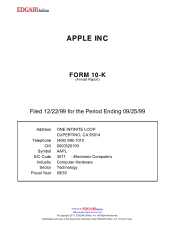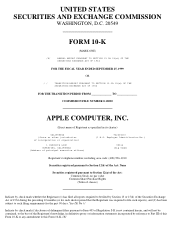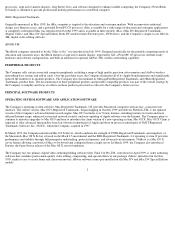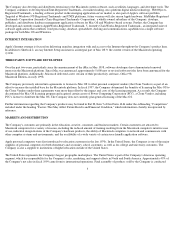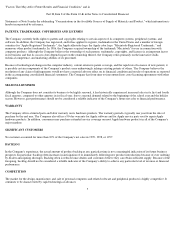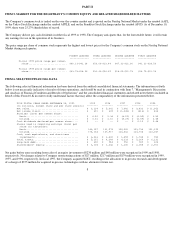Apple 1999 Annual Report Download - page 7
Download and view the complete annual report
Please find page 7 of the 1999 Apple annual report below. You can navigate through the pages in the report by either clicking on the pages listed below, or by using the keyword search tool below to find specific information within the annual report.in the Company's manufacturing facilities in California, Singapore, and Cork, Ireland, and by external vendors in Taiwan, Korea, Mexico, and
the United Kingdom.
The Company distributes its products through wholesalers, resellers, national and regional retailers and cataloguers, and directly to education
institutions for resale (collectively referred to as "resellers"). The Company also sells many of its products in most of its major markets directly
to end users through its on-line store. Throughout fiscal 1998, the Company revised its distribution channel model and related policies. As a
result, the Company significantly reduced the number of its distributors, authorized resellers, and national retail channel partners, particularly in
the United States. The Company also revised its distribution channel policies including decreasing the price protection and stock return
privileges of its remaining distributors and resellers.
RAW MATERIALS
Although certain components essential to the Company's business are generally available from multiple sources, other key components
(including microprocessors and application-specific integrated circuits (ASICs)) are currently obtained by the Company from single or limited
sources. Some other key components (including without limitation DRAM and TFT-LCD flat-panel displays), while currently available to the
Company from multiple sources, are at times subject to industry wide availability and pricing pressures. Any availability limitations,
interruption in supplies, or price increases relative to these and other components could adversely affect the Company's business and financial
results. In addition, new products introduced by the Company often initially utilize custom components obtained from only one source until the
Company has evaluated whether there is a need for and subsequently qualifies additional suppliers. In situations where a component or product
utilizes new technologies, initial capacity constraints may exist until such time as the suppliers' yields have matured. Components are normally
acquired through purchase orders, as is common in the industry, typically covering the Company's requirements for periods from 60 to 120
days. However, the Company continues to evaluate the need for a supply contract in each situation.
If the supply of a key component to the Company were to be delayed or curtailed or in the event a key manufacturing vendor delays shipment
of completed products to the Company, the Company's ability to ship products in desired quantities and in a timely manner could be adversely
affected. The Company's business and financial performance could also be adversely affected, depending on the time required to obtain
sufficient quantities from the original source or, if possible, to identify and obtain sufficient quantities from an alternative source. In addition to
its current suppliers of DRAM and TFT-LCD flat-panel displays, the Company believes the component suppliers and manufacturing vendors
whose loss to the Company could have a material adverse effect upon the Company's business and financial position include, at this time:
Alpha-Top Corporation, Ambit Microsystems Corporation, ATI Technologies, Inc., Canon, Inc., Darfon Electronics Corporation, IBM
Corporation, LG Electronics, Matsushita, Motorola, Inc., NatSteel Electronics PTE Ltd., Philips Semiconductors, Quanta Computer, Inc., and
Samsung Electronics. The Company attempts to mitigate these potential risks by working closely with these and other key suppliers on product
introduction plans, strategic inventories, coordinated product introductions, and internal and external manufacturing schedules and levels. The
Company believes many of its single-source suppliers, including most of the foregoing companies, are reliable multinational corporations. The
Company also believes most of these suppliers manufacture the relevant components in multiple plants. The Company further believes its long-
standing business relationships with many of these and other key suppliers are strong and mutually beneficial in nature.
The Company has from time to time experienced significant price increases and limited availability of certain components that are available
from multiple sources. Any similar occurrences in the future could have an adverse effect on the Company's operating results.
Further discussion relating to availability and supply of components and product may be found in Part II, Item 7 of this Form 10-K under the
subheading "Inventory and Supply" included under the heading
4

